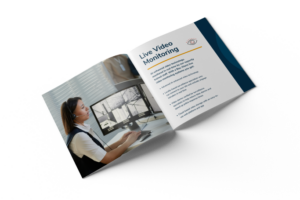
How to measure the ROI of your business security system
Every business has expenses—some essential, like rent, and others considered investments, like marketing. But where do security systems fall? Many see security as just another cost—a necessary but expensive line item.
What if you viewed security as an investment with measurable returns? Calculating the ROI of business security isn’t just possible, it’s a smart way to understand its true value.
A modern security system does more than just deter crime. It provides valuable data, improves operational efficiency, and protects your bottom line in ways you might not expect. In this post, we’ll break down how to measure the real return on your security investment, helping you see it as a powerful tool for business growth and stability.
What does “ROI” really mean for a business security system?
Return on Investment (ROI) is a simple formula:
Net Profit ÷ Cost of Investment × 100
For a new employee training program, it’s easy—you track improvements in productivity or reduced errors. For security, the “profit” isn’t always direct cash in hand. Instead, the ROI of business security is often measured in cost avoidance and efficiency gains.
- Cost avoidance: Money saved from preventing incidents like theft, damage, or legal issues from ever happening.
- Efficiency gains: Money saved by improving processes and reducing operational waste often through better monitoring or management.
Think of it this way: the return comes from the money you didn’t lose. It’s the value of stolen assets you kept, the fraudulent liability claims you did not have to prove, and the operational bottlenecks you fixed. A comprehensive security system generates returns by protecting your assets, people, and profits from a wide range of threats.
How much can you save by reducing theft, vandalism, and unauthorized access?
Preventing loss is the most direct financial benefit of a security system. Losses from theft—both external and internal—can be devastating. According to the National Retail Federation, retail shrink cost businesses over $100 billion in a recent year. Calculating your savings here involves looking at your past losses and estimating future prevention.
- Track your inventory shrinkage: Before installing or upgrading a system, what was your average monthly or annual loss due to theft? If your total investment is less than this number over the same period of time, then your ROI is positive.
- Document vandalism costs: How much have you spent on repairs from vandalism or property damage? Visible cameras are a powerful deterrent. The reduction in these repair bills is a tangible saving.
- Prevent unauthorized access: Access control systems prevent non-employees from entering sensitive areas. This stops potential theft of physical assets, intellectual property, or confidential data before it can even happen.

For example, if your business was losing an average of $5,000 annually to employee theft and that number drops to $500 after installing interior cameras, you’ve saved $4,500. That’s a powerful and direct return on your investment.
Can investing in a security system lower your insurance premiums and liability?
Yes, it absolutely can.
Insurance providers love to see businesses taking proactive steps to reduce risk. A professionally installed and monitored security system is a clear signal that you are serious about protecting your property. Many insurers offer significant discounts on business insurance premiums for properties with comprehensive security measures.
When you get a quote, be sure to ask your insurance agent what discounts are available for:
- Professionally monitored burglar alarms
- Fire alarm and sprinkler monitoring
- Video surveillance systems (CCTV)
- Access control systems
Beyond premiums, video surveillance is a powerful tool for reducing liability. If a false slip-and-fall claim is filed against you, video evidence can quickly disprove it, saving you from potentially massive legal fees and settlement costs. This protection against fraudulent claims is a major component of the ROI of business security.
How do operational improvements tie into your security investment value?
This is where the value of a modern security system really shines. It’s no longer just about catching criminals; it’s about making your business run better. High-quality video surveillance allows you to see how your business operates when you’re not there.
You can use video footage to:
- Optimize employee productivity: Are staff following procedures? Are there workflow bottlenecks you can identify and fix? Video can provide insights to improve training and efficiency.
- Improve customer service: You can review customer interactions to ensure your team is providing the best possible service. It’s a great tool for training and quality control.
- Settle employee disputes: If a disagreement occurs between staff members or with a customer, video footage provides an objective record of what happened, allowing for fair and swift resolution.
- Monitor remote locations: For businesses with multiple sites, a centralized video system allows you to keep an eye on all operations from one place, saving travel time and costs.
- Track deliveries and after-hours site access: Video surveillance helps verify when deliveries arrive and ensures only authorized personnel enter the premises outside regular hours. This added visibility strengthens security and accountability across your operations.
These operational gains lead to a stronger, more profitable business. While harder to quantify than theft reduction, these efficiencies contribute directly to your bottom line over time.
What is a realistic payback period for commercial security upgrades?
The payback period is the time it takes for your net savings to equal the initial cost of the system. This varies widely based on your industry, location, and specific risks. A retail store in a high-crime area might see a payback period of less than a year, thanks to a dramatic reduction in shoplifting. For an office building with low historic losses, the payback period may be longer, with the return focused more on liability protection and operational efficiency.
To estimate your payback period, add up all your potential annual savings (theft reduction + insurance discounts + operational gains) and divide your total investment cost by that number. For example:
- Total System Cost: $10,000
- Annual Savings:
- Reduced Theft: $4,500
- Insurance Discount: $1,200
- Estimated Efficiency Gain: $1,000
- Total Annual Savings: $6,700
Payback Period: $10,000 / $6,700 = 1.5 years
In this scenario, the system pays for itself in just 18 months and continues to provide value for years to come.
How to build a business case for a security system upgrade or overhaul
If you need to get approval for a security investment, you need to present a clear, data-driven case. Don’t just focus on the features; focus on the financial benefits and the ROI of business security.
- Start with a Risk Assessment: Identify your biggest vulnerabilities. Is it employee theft? Shoplifting? Vandalism? Data security? Use historical data on losses.
- Quantify the Costs: Put a dollar amount on your current losses. Include direct costs (stolen goods) and indirect costs (repair bills, time spent dealing with incidents).
- Get a Professional Quote: Work with a reputable security provider to design a system that directly addresses your identified risks. At Bay Alarm, we specialize in creating custom solutions tailored to your business needs.
- Project the Savings: Use the framework above to estimate your annual savings in theft reduction, insurance discounts, and operational improvements.
- Calculate the ROI and Payback Period: Present the numbers clearly. Show stakeholders not how much the system costs, but how much it will save and earn the business over time.
By framing the conversation around tangible returns, you transform a security system from an expense into a strategic investment in the health and profitability of your business.
Start a conversation with a Bay Alarm security expert.
By submitting this form, you agree to receive marketing emails from Bay Alarm. You can unsubscribe at any time.

